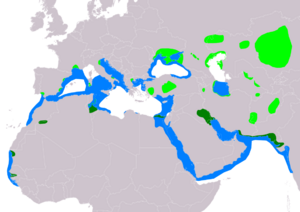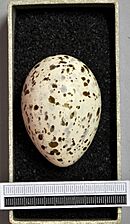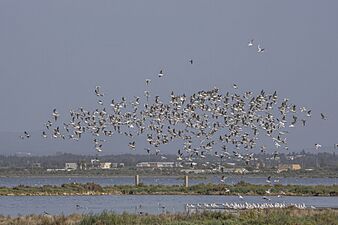Slender-billed gull facts for kids
Quick facts for kids Slender-billed gull |
|
|---|---|
 |
|
| Winter plumage, Bahrain | |
| Conservation status | |
| Scientific classification | |
| Genus: |
Chroicocephalus
|
| Species: |
genei
|
 |
|
| Range of C. genei Breeding Resident Non-breeding | |
| Synonyms | |
|
Larus genei |
|
The slender-billed gull (Chroicocephalus genei) is a medium-sized gull. It lives and breeds in special places around the Mediterranean Sea. You can also find it in the northern part of the western Indian Ocean, like Pakistan. These gulls often build their nests on islands or in coastal lagoons.
Most slender-billed gulls are migratory. This means they fly south for the winter. They travel to places like North Africa and India. Sometimes, a few gulls might fly off course. They have been seen in western Europe. One even made it all the way to Antigua in 1976!
The name Chroicocephalus comes from Ancient Greek words. They mean "to colour" and "head." The second part of its name, genei, honors an Italian scientist named Giuseppe Gené.
What Does It Look Like?
This gull is about 37 to 40 centimeters (15 to 16 inches) long. Its wings can spread out to 90 to 102 centimeters (35 to 40 inches). It is a bit bigger than the black-headed gull. However, it does not have a black head in summer.
The slender-billed gull has a light gray body. Its head and chest are white. The tips of its main wing feathers are black. Its head and dark red beak look long and pointy. It also seems to have a long neck. Its legs are dark red, and its eyes are yellow. In summer, its chest gets a light pink color.
Like many gulls, it takes two years for this bird to grow up. Young gulls in their first year have a black band on their tail. They also have dark spots on their wings.
Where Does It Live?
Slender-billed gulls build their nests in lagoons and lakes. These are found around the Mediterranean Sea. They also live in similar places near the northwestern Indian Ocean. In 2010, a group of these gulls successfully nested on an island. This island was in a mountain lake in Algeria. Almost all their eggs hatched there. This was because there were no predators or disturbances.
In winter, these gulls move to coastal areas. They like to stay in estuaries (where rivers meet the sea) and bays. They find food in river deltas, marshes, and grassy areas. They are also one of the types of gulls that look for food at landfill sites.
How It Lives and Eats
About half of what the slender-billed gull eats is fish. It flies a few meters above the water. When it sees food, it dives into the water. It also uses its beak to poke in the mud. This helps it find small sea creatures. Sometimes, it even catches insects while flying.
This gull is not very common. It nests in large groups called colonies. They make their nests on the ground. They lay up to three white eggs with brown spots. The nest is a simple scrape lined with a few feathers and plant bits. The eggs hatch after about 25 days. The young birds can fly after another 25 days.
In winter, these gulls like to be with other gulls. They gather together to find food. They also gather in groups to sleep at night. They usually stay near land and are rarely seen far out at sea.
Is It Safe?
The slender-billed gull is part of an important agreement. This agreement is called the Agreement on the Conservation of African-Eurasian Migratory Waterbirds (AEWA). This means that people are working to protect these birds. They want to make sure these gulls can continue to migrate and live safely.






